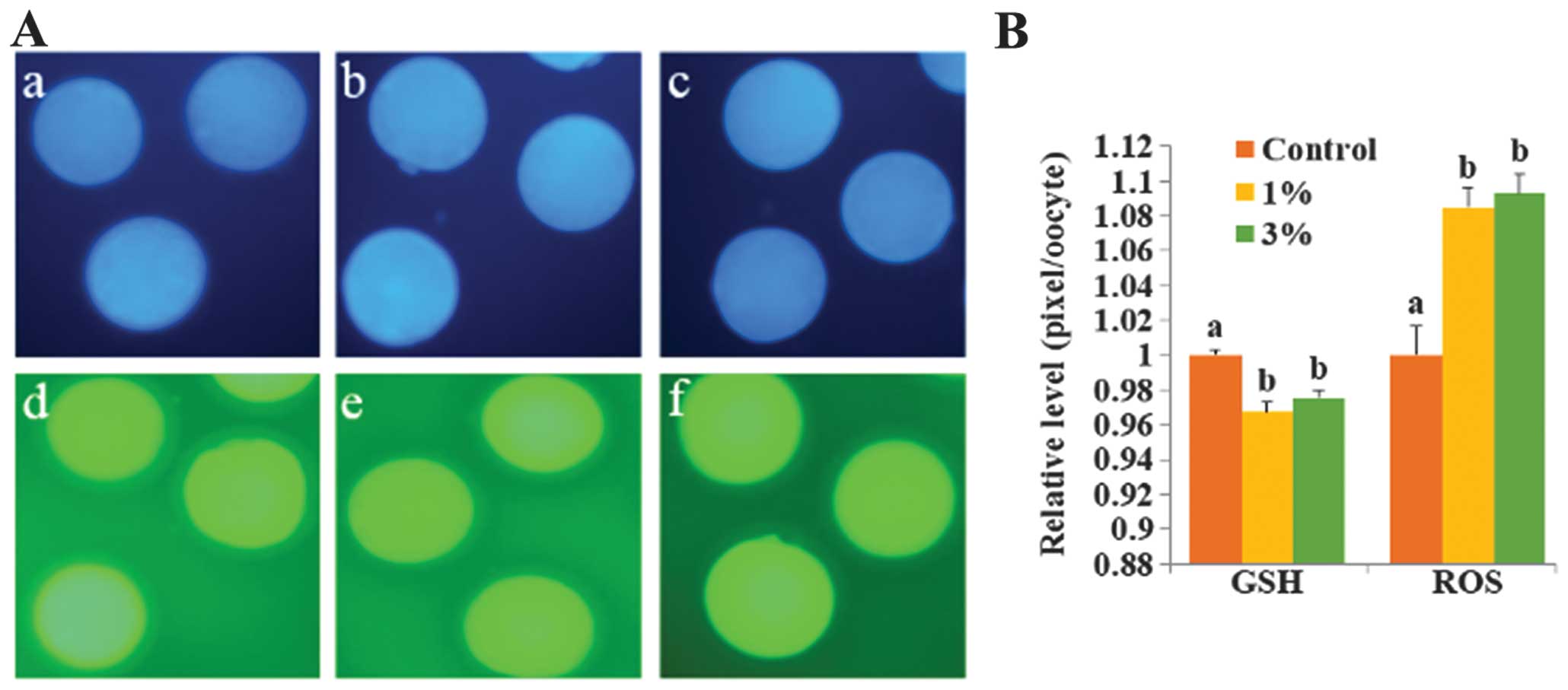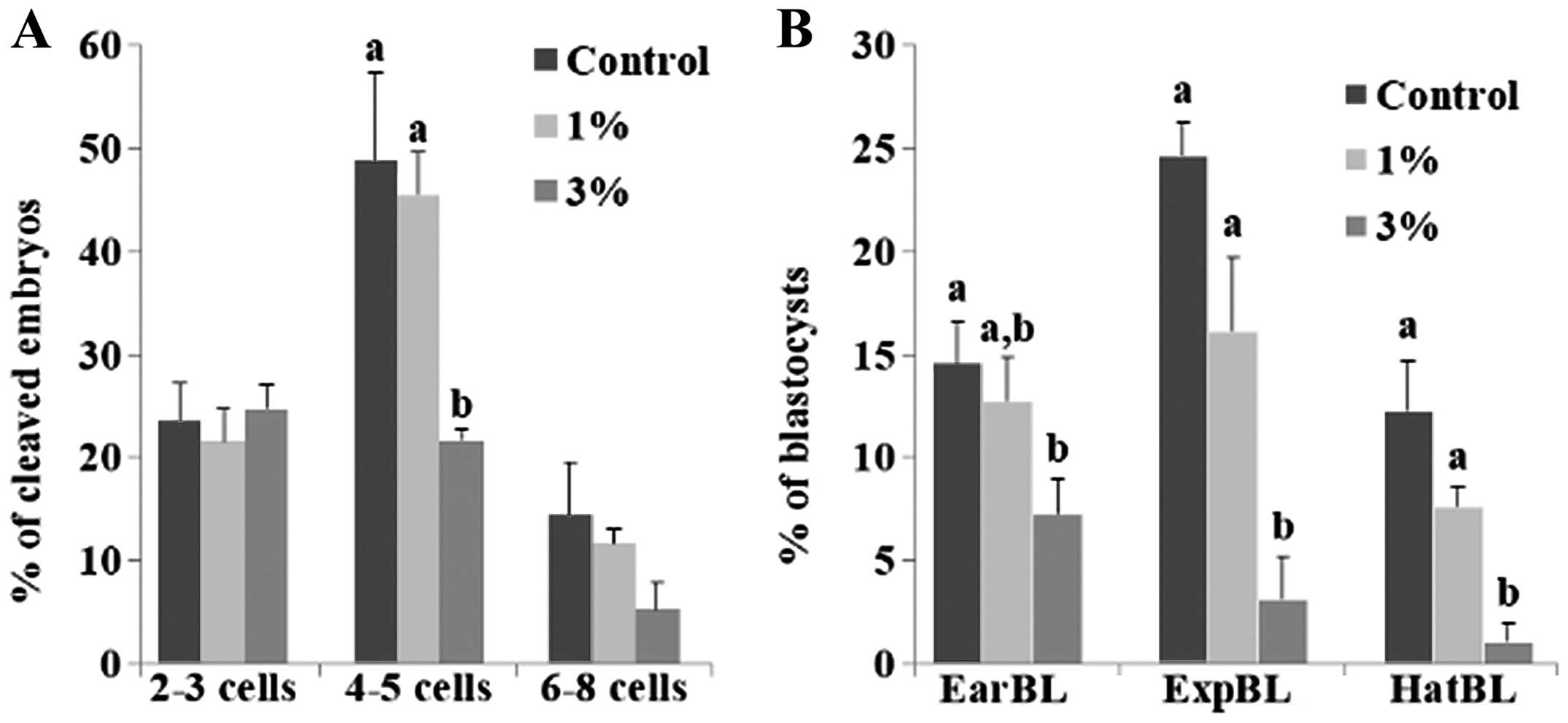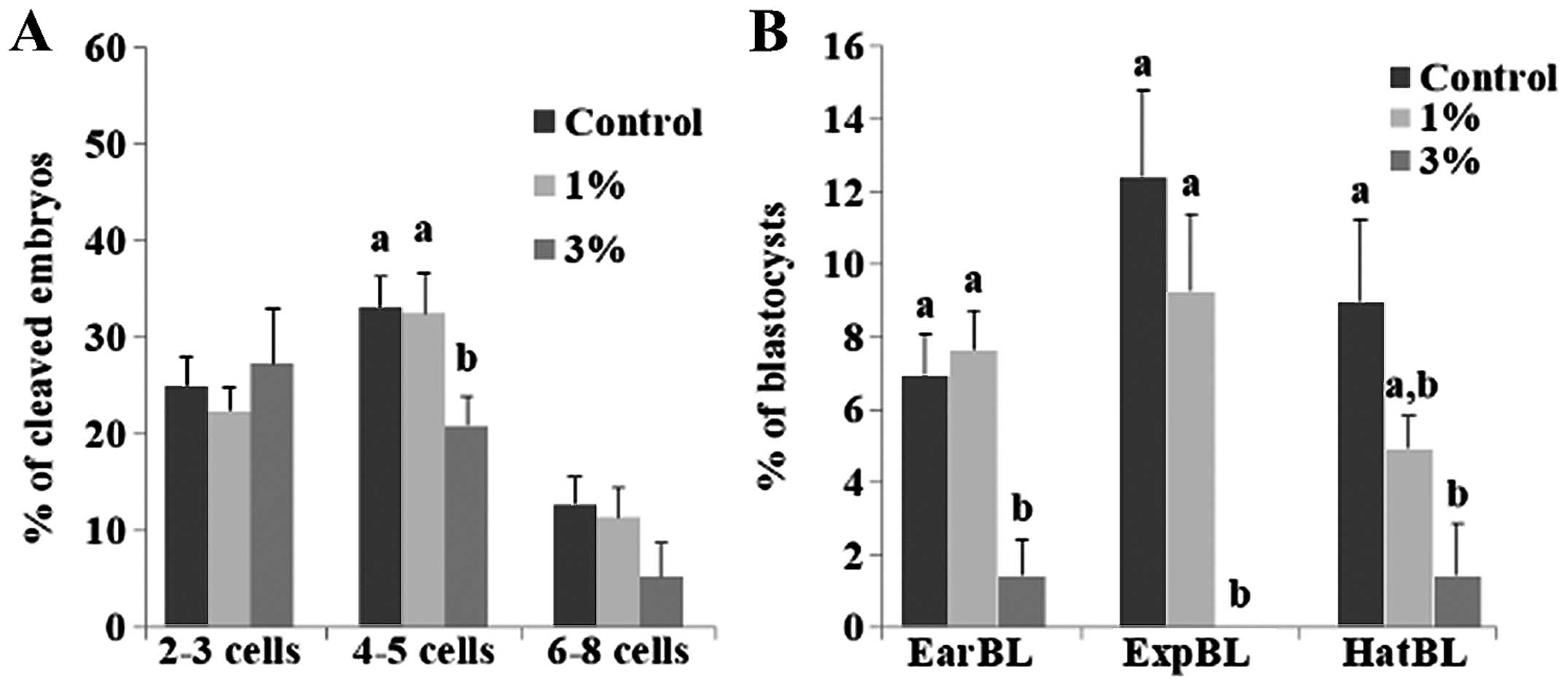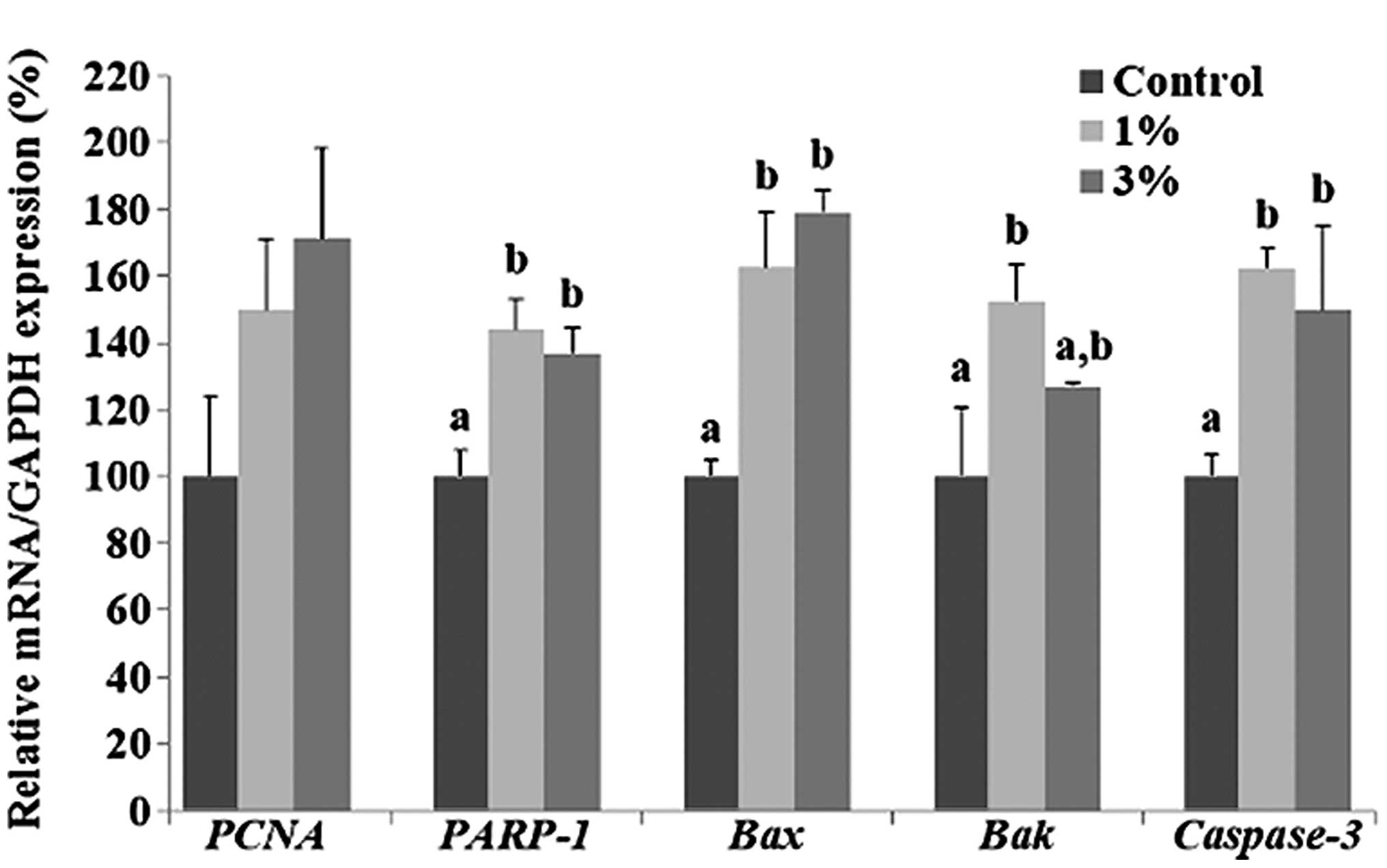|
1
|
Prather RS, Hawley RJ, Carter DB, Lai L
and Greenstein JL: Transgenic swine for biomedicine and
agriculture. Theriogenology. 59:115–123. 2003. View Article : Google Scholar : PubMed/NCBI
|
|
2
|
Meurens F, Summerfield A, Nauwynck H, Saif
L and Gerdts V: The pig: a model for human infectious diseases.
Trends Microbiol. 20:50–57. 2012. View Article : Google Scholar : PubMed/NCBI
|
|
3
|
Marco-Jiménez F, Llobat L and Vicente JS:
Effects of lanosterol on in vitro maturation of porcine oocytes.
Anim Reprod Sci. 117:288–294. 2010.PubMed/NCBI
|
|
4
|
Avery B, Faerge I, Grøndahl C and Ottesen
J: Nuclear maturation and embryo development of bovine oocytes,
matured in a semi-defined medium supplemented with meiosis
activating sterol (MAS). Theriogenology. 51:3671999. View Article : Google Scholar
|
|
5
|
Martino A, Songsasen N and Leibo SP:
Development into blastocysts of bovine oocytes cryopreserved by
ultra-rapid cooling. Biol Reprod. 54:1059–1069. 1996. View Article : Google Scholar : PubMed/NCBI
|
|
6
|
Vajta G, Holm P, Kuwayama M, et al: Open
Pulled Straw (OPS) vitrification: a new way to reduce cryoinjuries
of bovine ova and embryos. Mol Reprod Dev. 51:53–58. 1998.
View Article : Google Scholar : PubMed/NCBI
|
|
7
|
Barboni B and Mattioli M: Oocyte
maturation involves important changes required for activation
competence. Reprod Domest Anim. 31:589–594. 1996.
|
|
8
|
Fukui Y, Sawai K, Furudate M, Sato N,
Iwazumi Y and Ohsaki K: Parthenogenetic development of bovine
oocytes treated with ethanol and cytochalasin B after in vitro
maturation. Mol Reprod Dev. 33:357–362. 1992. View Article : Google Scholar : PubMed/NCBI
|
|
9
|
Balakier H and Casper RF: Experimentally
induced parthenogenetic activation of human oocytes. Hum Reprod.
8:740–743. 1993.PubMed/NCBI
|
|
10
|
Rybouchkin A, Dozortsev D, De Sutter P and
Dhont M: Factors affecting the role of the spindle during early
response of mouse oocytes to ethanol stimulation. J Exp Zool.
275:469–475. 1996. View Article : Google Scholar : PubMed/NCBI
|
|
11
|
Novitskiy G, Traore K, Wang L, Trush MA
and Mezey E: Effects of ethanol and acetaldehyde on reactive oxygen
species production in rat hepatic stellate cells. Alcohol Clin Exp
Res. 30:1429–1435. 2006. View Article : Google Scholar : PubMed/NCBI
|
|
12
|
Mameli M, Botta P, Zamudio PA, Zucca S and
Valenzuela CF: Ethanol decreases Purkinje neuron excitability by
increasing GABA release in rat cerebellar slices. J Pharmacol Exp
Ther. 327:910–917. 2008. View Article : Google Scholar : PubMed/NCBI
|
|
13
|
Caires KC, Shima CM, de Avila J and McLean
DJ: Acute ethanol exposure affects spermatogonial stem cell
homeostasis in pre-pubertal mice. Reprod Toxicol. 33:76–84. 2012.
View Article : Google Scholar : PubMed/NCBI
|
|
14
|
Cherian PP, Schenker S and Henderson GI:
Ethanol-mediated DNA damage and PARP-1 apoptotic responses in
cultured fetal cortical neurons. Alcohol Clin Exp Res.
32:1884–1892. 2008.PubMed/NCBI
|
|
15
|
Hengartner MO: The biochemistry of
apoptosis. Nature. 407:770–776. 2000. View
Article : Google Scholar : PubMed/NCBI
|
|
16
|
Kameshita I, Matsuda Z, Taniguchi T and
Shizuta Y: Poly (ADP-Ribose) synthetase. Separation and
identification of three proteolytic fragments as the
substrate-binding domain, the DNA-binding domain, and the
automodification domain. J Bioll Chem. 259:4770–4776. 1984.
|
|
17
|
Virág L and Szabó C: The therapeutic
potential of poly (ADP-ribose) polymerase inhibitors. Pharmacol
Rev. 54:375–429. 2002.
|
|
18
|
Hong SJ, Dawson TM and Dawson VL: Nuclear
and mitochondrial conversations in cell death: PARP-1 and AIF
signaling. Trends Pharmacol Sci. 25:259–264. 2004. View Article : Google Scholar : PubMed/NCBI
|
|
19
|
You J, Kim J, Lim J and Lee E: Anthocyanin
stimulates in vitro development of cloned pig embryos by increasing
the intracellular glutathione level and inhibiting reactive oxygen
species. Theriogenology. 74:777–785. 2010. View Article : Google Scholar : PubMed/NCBI
|
|
20
|
Nasr-Esfahani MH, Aitken JR and Johnson
MH: Hydrogen peroxide levels in mouse oocytes and early cleavage
stage embryos developed in vitro or in vivo. Development.
109:501–507. 1990.PubMed/NCBI
|
|
21
|
Baker MA, Cerniglia GJ and Zaman A:
Microtiter plate assay for the measurement of glutathione and
glutathione disulfide in large numbers of biological samples. Anal
Biochem. 190:360–365. 1990. View Article : Google Scholar : PubMed/NCBI
|
|
22
|
Abeydeera LR and Day BN: In vitro
penetration of pig oocytes in a modified Tris-buffered medium:
effect of BSA, caffeine and calcium. Theriogenology. 48:537–544.
1997. View Article : Google Scholar : PubMed/NCBI
|
|
23
|
Gil MA, Ruiz M, Vazquez JM, Roca J, Day BN
and Martinez EA: Effect of short periods of sperm-oocyte
coincubation during in vitro fertilization on embryo
development in pigs. Theriogenology. 62:544–552. 2004. View Article : Google Scholar : PubMed/NCBI
|
|
24
|
Yoshioka K, Suzuki C, Tanaka A, Anas IM
and Iwamura S: Birth of piglets derived from porcine zygotes
cultured in a chemically defined medium. Biol Reprod. 66:112–119.
2002. View Article : Google Scholar : PubMed/NCBI
|
|
25
|
Cheng TC, Huang CC, Huang LS, Chen CI, Lee
MS and Liu JY: Evaluation of mouse blastocyst implantation rate by
morphology grading. Chin J Physiol. 47:43–47. 2004.PubMed/NCBI
|
|
26
|
Hall V, Hinrichs K, Lazzari G, Betts DH
and Hyttel P: Early embryonic development, assisted reproductive
technologies, and pluripotent stem cell biology in domestic
mammals. Vet J. 197:128–142. 2013. View Article : Google Scholar : PubMed/NCBI
|
|
27
|
Gil MA, Cuello C, Parrilla I, Vazquez JM,
Roca J and Martinez EA: Advances in swine in vitro embryo
production technologies. Reprod Domest Anim. 45(Suppl 2): S40–S48.
2010. View Article : Google Scholar
|
|
28
|
Funahashi H and Day BN: Advances in in
vitro production of pig embryos. J Reprod Fertil Suppl. 52:271–283.
1997.PubMed/NCBI
|
|
29
|
Coy P and Romar R: In vitro production of
pig embryos: a point of view. Reprod Fertil Dev. 14:275–286. 2002.
View Article : Google Scholar : PubMed/NCBI
|
|
30
|
De Matos DG and Furnus CC: The importance
of having high glutathione (GSH) level after bovine in vitro
maturation on embryo development: effect of beta-mercaptoethanol,
cysteine and cystine. Theriogenology. 53:761–771. 2000.PubMed/NCBI
|
|
31
|
Abeydeera LR, Wang WH, Cantley TC, Prather
RS and Day BN: Presence of beta-mercaptoethanol can increase the
glutathione content of pig oocytes matured in vitro and the rate of
blastocyst development after in vitro fertilization.
Theriogenology. 50:747–756. 1998. View Article : Google Scholar : PubMed/NCBI
|
|
32
|
Luberda Z: The role of glutathione in
mammalian gametes. Reprod Biol. 5:5–17. 2005.PubMed/NCBI
|
|
33
|
Brad AM, Bormann CL, Swain JE, et al:
Glutathione and adenosine triphosphate content of in vivo and in
vitro matured porcine oocytes. Mol Reprod Dev. 64:492–498. 2003.
View Article : Google Scholar : PubMed/NCBI
|
|
34
|
Meister A: Selective modification of
glutathione metabolism. Science. 220:472–477. 1983. View Article : Google Scholar
|
|
35
|
Avery B and Greve T: Effects of ethanol
and dimethylsulphoxide on nuclear and cytoplasmic maturation of
bovine cumulus-oocyte complexes. Mol Reprod Dev. 55:438–445. 2000.
View Article : Google Scholar : PubMed/NCBI
|
|
36
|
Park SH, Park SB and Kim NH: Expression of
early development-related genes in bovine nuclear transferred and
fertilized embryos. Zygote. 11:355–360. 2003. View Article : Google Scholar : PubMed/NCBI
|
|
37
|
Zhou W, Xiang T, Walker S, et al: Global
gene expression analysis of bovine blastocysts produced by multiple
methods. Mol Reprod Dev. 75:744–758. 2008. View Article : Google Scholar : PubMed/NCBI
|
|
38
|
De Sousa PA, Caveney A, Westhusin ME and
Watson AJ: Temporal patterns of embryonic gene expression and their
dependence on oogenetic factors. Theriogenology. 49:115–128.
1998.PubMed/NCBI
|
|
39
|
Hashimoto S, Saeki K, Nagao Y, Minami N,
Yamada M and Utsumi K: Effects of cumulus cell density during in
vitro maturation on the developmental competence of bovine oocytes.
Theriogenology. 49:1451–1463. 1998. View Article : Google Scholar : PubMed/NCBI
|
|
40
|
Jurisicova A, Latham KE, Casper RF and
Varmuza SL: Expression and regulation of genes associated with cell
death during murine preimplantation embryo development. Mol Reprod
Dev. 51:243–253. 1998. View Article : Google Scholar : PubMed/NCBI
|
|
41
|
Byrne AT, Southgate J, Brison DR and Leese
HJ: Analysis of apoptosis in the preimplantation bovine embryo
using TUNEL. J Reprod Fertil. 117:97–105. 1999. View Article : Google Scholar : PubMed/NCBI
|
|
42
|
Makarevich AV and Markkula M: Apoptosis
and cell proliferation potential of bovine embryos stimulated with
insulin-like growth factor I during in vitro maturation and
culture. Biol Reprod. 66:386–392. 2002. View Article : Google Scholar : PubMed/NCBI
|
|
43
|
Wu MH, Chang JH and Yung BY: Resistance to
UV-induced cell-killing in nucleophosmin/B23 over-expressed NIH 3T3
fibroblasts: enhancement of DNA repair and up-regulation of PCNA in
association with nucleophosmin/B23 over-expression. Carcinogenesis.
23:93–100. 2002. View Article : Google Scholar : PubMed/NCBI
|
|
44
|
Zong WX, Li C, Hatzivassiliou G, et al:
Bax and Bak can localize to the endoplasmic reticulum to initiate
apoptosis. J Cell Biol. 162:59–69. 2003. View Article : Google Scholar : PubMed/NCBI
|
|
45
|
Gandolfi TA and Gandolfi F: The maternal
legacy to the embryo: cytoplasmic components and their effects on
early development. Theriogenology. 55:1255–1276. 2001. View Article : Google Scholar : PubMed/NCBI
|
|
46
|
Ramachandran V, Watts LT, Maffi SK, Chen
J, Schenker S and Henderson G: Ethanol-induced oxidative stress
precedes mitochondrially mediated apoptotic death of cultured fetal
cortical neurons. J Neurosci Res. 74:577–588. 2003. View Article : Google Scholar
|
|
47
|
Ramachandran V, Perez A, Chen J, Senthil
D, Schenker S and Henderson GI: In utero ethanol exposure causes
mitochondrial dysfunction, which can result in apoptotic cell death
in fetal brain: a potential role for 4-hydroxynonenal. Alcohol Clin
Exp Res. 25:862–871. 2001. View Article : Google Scholar
|
|
48
|
Yu SW, Wang H, Poitras MF, et al:
Mediation of poly(ADP-ribose) polymerase-1-dependent cell death by
apoptosis-inducing factor. Science. 297:259–263. 2002. View Article : Google Scholar : PubMed/NCBI
|
|
49
|
Yu SW, Andrabi SA, Wang H, et al:
Apoptosis-inducing factor mediates poly(ADP-ribose) (PAR)
polymer-induced cell death. Proc Natl Acad Sci USA.
103:18314–18319. 2006. View Article : Google Scholar : PubMed/NCBI
|
|
50
|
Strosznajder JB, Czapski GA, Adamczyk A
and Strosznajder RP: Poly(ADP-ribose) polymerase-1 in amyloid beta
toxicity and Alzheimer’s disease. Mol Neurobiol. 46:78–84.
2012.PubMed/NCBI
|


















